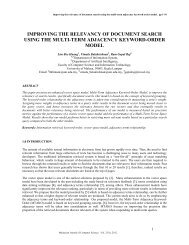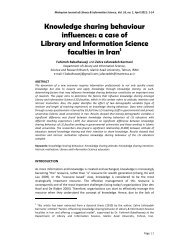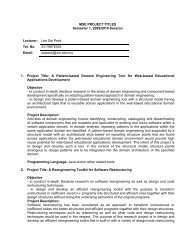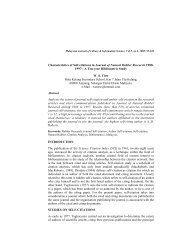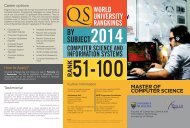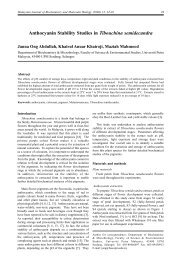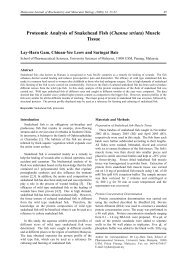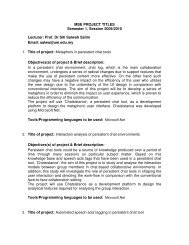DESIGN AND IMPLEMENTATION OF A PRIVATE AND PUBLIC KEY ...
DESIGN AND IMPLEMENTATION OF A PRIVATE AND PUBLIC KEY ...
DESIGN AND IMPLEMENTATION OF A PRIVATE AND PUBLIC KEY ...
You also want an ePaper? Increase the reach of your titles
YUMPU automatically turns print PDFs into web optimized ePapers that Google loves.
Design and Implementation of a Private and Public Key Crypto Processor for Next-Generation IT Security Applications pp. 29 - 45on 4-state pipeline so as to increase the maximum running frequency and timing performance. It consists of threemain modules, which are KeyGen, Control Unit and Encryption/Decryption Unit. The KeyGen is designed togenerate the roundkey for AddRoundKey transformation in every round. The data path for encryption/decryption isas follows:Pt/Ct → m2 → ARK → M-SB → M-SR → M-MC → m1 → m2 → ARK → Ct/Pt.We implemented the SubBytes block (S-box) based on the calculation of multiplicative inverse and affine transforminstead of using ROM-based lookup table to reduce the hardware logic count.ClkResetM-SB : Mixed SubBytesM-SR : Mixed ShiftRowM-MC : MixedMixColumnARK : AddRoundKeyPt/Ct :Plaintext/CiphertextCt/Pt :Ciphertext/Plaintextm1 : multiplexer 1m2 : multiplexer 2Encryption/DecryptionEncDec datapath M - SBEncDecEncDecPt / CtEncDec128M - SRM - MC128128ARKCt / Pt128m1m2128128Sel_M1KeyBitSel_M2 ReadResultKeyBitRequestLoadDataLoadKeyDoneEncDecKeySelectUpdateKeyKeyRequestDataRequestSel_M1(Final Round)Sel_M2 (First Round)KeyGenClkControlunitResetFig. 5: Block diagram of the AES-128 coreKeykeySelEncDecKeyBit_RequestFirst_RoundFinal_RoundKeyValidDataValidStartEnc4.2 RSA Processor for Public Key CryptographyThe RSA algorithm, invented in 1977 by Rivest, Shamir, and Adleman [7], is currently the most popular public keycryptosystem in use, particularly in high-end commercial software products that are typically employed in e-commerce and VPN servers. It can provide encryption and digital signatures. In hardware implementations, theRSA algorithm can be found in secure telephones, in Ethernet network cards, and smart cards. The main advantageof the algorithm is that it can provide both data confidentiality service (via public-key encryption) and data integrity,authentication and non-repudiation (via digital signatures) using the same key pair and under the same mathematicaloperation. Its hard problem is based on the large integer factorization problem.RSA algorithm is the essence of simplicity [8]. To encrypt a message X to its cipher text P, we perform P = X E modM using the public key (E, M). To restore the message, X= P D mod M is performed, where (D, M) is the private key.For digital signature purpose, we use the private key in signing, S = X D mod M. To verify the signature, we use thepublic key to perform X = S E mod M. Fig. 6 below shows the RSA process. In RSA, whether encrypting,decrypting, signing, or verifying, the operation is basically a wide-operand modular exponentiation. The basicmodular exponentiation equation, given by: Y = X E mod M, essentially consists of thousands of modularmultiplication, A.B mod M, in GF(p). Thus, the modular exponentiation is computation-intensive and requires a longcomputation time. A proven method to speed up its operation time is to utilize Montgomery modularmultiplications, which do not have divisions.Fig. 6: RSA operationThe Modular Exponentiation algorithm, ModExp( ), applied in this work is given in Algorithm 1, Fig. 7 below. Itutilizes the Montgomery modular multiplication, MonMult( ), with the algorithm given in Fig. 8. For hardwareimplementation, the multi-precision version of Montgomery multiplication is employed, in which the algorithm34Malaysian Journal of Computer Science, Vol. 19(1), 2006



